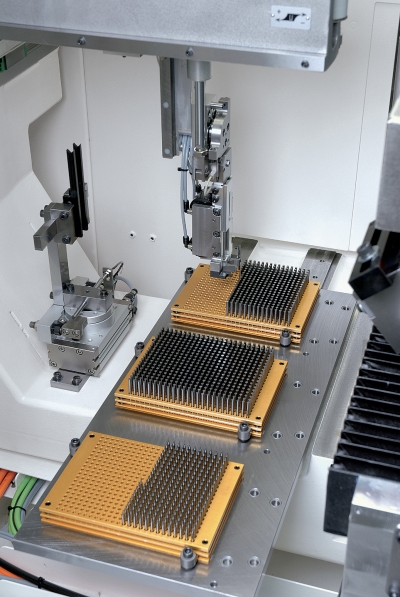
Tool precision depends directly on the production accuracy of the blanks used. There is a new addition to the market to create complex geometries with exact concentricity and dimensional accuracy: the cylindrical grinding machine ShapeSmart NP3+ from Rollomatic. Thanks to its modular structure, the machine can be easily adapted to any requirement and any budget.
The market demands ever greater flexibility, smaller batch sizes and increased efficiency in production. Manufacturers meet this demand with high-precision tools as an important performance factor. “But only those who enter the race with perfectly prepared blanks have any chance of a pole position in the formula one of precision heavy weights. High carbide quality is one factor, but only grinding on modern cylindrical grinding machines provides a great basis for high-precision milling tools, drilling tools or punching tools,” says Damien Wunderlin, head of marketing and sales at Rollomatic SA in Le Landeron, Switzerland. “We’ve therefore expanded one of our classics from an ergonomic and technical perspective with the result being the ShapeSmart NP3+, a powerful yet cost-effective cylindrical grinding machine.”
Available with three or four axes, the ShapeSmart NP3+ covers the usual requirements for a high-precision cylindrical grinding machine in the grinding range from 0.025 to 25.0 mm diameter. It works in accordance with the peel grinding principle and can perform roughing and finishing processes simultaneously. Rollomatic originally invented this technology and again facilitates never-before-achieved power in cylindrical grinding coupled with microprecision: this is how the workpiece guide system guarantees concentricity in the µm range. Even extreme lengths/diameters – e.g. for deep-hole drills or other special applications – are no problem for the NP3+ up to 400xD.
Users demand ultra-high precision. The Swiss company achieves this by continually optimizing the machine design and adapting the individual components in an ideal manner. In comparison to the popular predecessor model, the NP3, a few details have once again been enhanced. For example, Rollomatic uses a Fanuc panel with 15-inch display and integrated PC for the machine control. As Wunderlin comments: “Thanks to the new panel control and PC integrated, we were able to further enhance user-friendliness for the operator. In addition, the new panel control and PC makes it possible to integrate the in-process measuring gaging system so that the ShapeSmart NP3+ maintains even narrow tolerances as any potential deviations will be corrected automatically. This guarantees users optimum reproducibility and mirror finish surfaces in unattended operation – even for complex tool geometries.”
The pick-and-place tool loader enables everything from small to large batches to be ground unattended as it can manage up to 1,360 workpieces up to 300 mm long. With the Job Manager, 10 different tool profiles can be programmed and produced automatically. Thanks to the integrated flipper station, both ends of the workpiece can also be ground up to a length of 200 mm. The setting of the grinding wheel positions can be easily and automatically done with the gap control system. A 3D touch probe facilitates the localization of the tool end position that can be used for instance as second operation to peel grind undercuts on ground endmills. Indeed steps, cones and radii can be processed completely in one single chucking.
Contact Details
Related Glossary Terms
- cylindrical grinding
cylindrical grinding
Grinding operation in which the workpiece is rotated around a fixed axis while the grinding wheel is fed into the outside surface in controlled relation to the axis of rotation. The workpiece is usually cylindrical, but it may be tapered or curvilinear in profile. See centerless grinding; grinding.
- gang cutting ( milling)
gang cutting ( milling)
Machining with several cutters mounted on a single arbor, generally for simultaneous cutting.
- grinding
grinding
Machining operation in which material is removed from the workpiece by a powered abrasive wheel, stone, belt, paste, sheet, compound, slurry, etc. Takes various forms: surface grinding (creates flat and/or squared surfaces); cylindrical grinding (for external cylindrical and tapered shapes, fillets, undercuts, etc.); centerless grinding; chamfering; thread and form grinding; tool and cutter grinding; offhand grinding; lapping and polishing (grinding with extremely fine grits to create ultrasmooth surfaces); honing; and disc grinding.
- grinding machine
grinding machine
Powers a grinding wheel or other abrasive tool for the purpose of removing metal and finishing workpieces to close tolerances. Provides smooth, square, parallel and accurate workpiece surfaces. When ultrasmooth surfaces and finishes on the order of microns are required, lapping and honing machines (precision grinders that run abrasives with extremely fine, uniform grits) are used. In its “finishing” role, the grinder is perhaps the most widely used machine tool. Various styles are available: bench and pedestal grinders for sharpening lathe bits and drills; surface grinders for producing square, parallel, smooth and accurate parts; cylindrical and centerless grinders; center-hole grinders; form grinders; facemill and endmill grinders; gear-cutting grinders; jig grinders; abrasive belt (backstand, swing-frame, belt-roll) grinders; tool and cutter grinders for sharpening and resharpening cutting tools; carbide grinders; hand-held die grinders; and abrasive cutoff saws.
- grinding wheel
grinding wheel
Wheel formed from abrasive material mixed in a suitable matrix. Takes a variety of shapes but falls into two basic categories: one that cuts on its periphery, as in reciprocating grinding, and one that cuts on its side or face, as in tool and cutter grinding.
- milling
milling
Machining operation in which metal or other material is removed by applying power to a rotating cutter. In vertical milling, the cutting tool is mounted vertically on the spindle. In horizontal milling, the cutting tool is mounted horizontally, either directly on the spindle or on an arbor. Horizontal milling is further broken down into conventional milling, where the cutter rotates opposite the direction of feed, or “up” into the workpiece; and climb milling, where the cutter rotates in the direction of feed, or “down” into the workpiece. Milling operations include plane or surface milling, endmilling, facemilling, angle milling, form milling and profiling.







